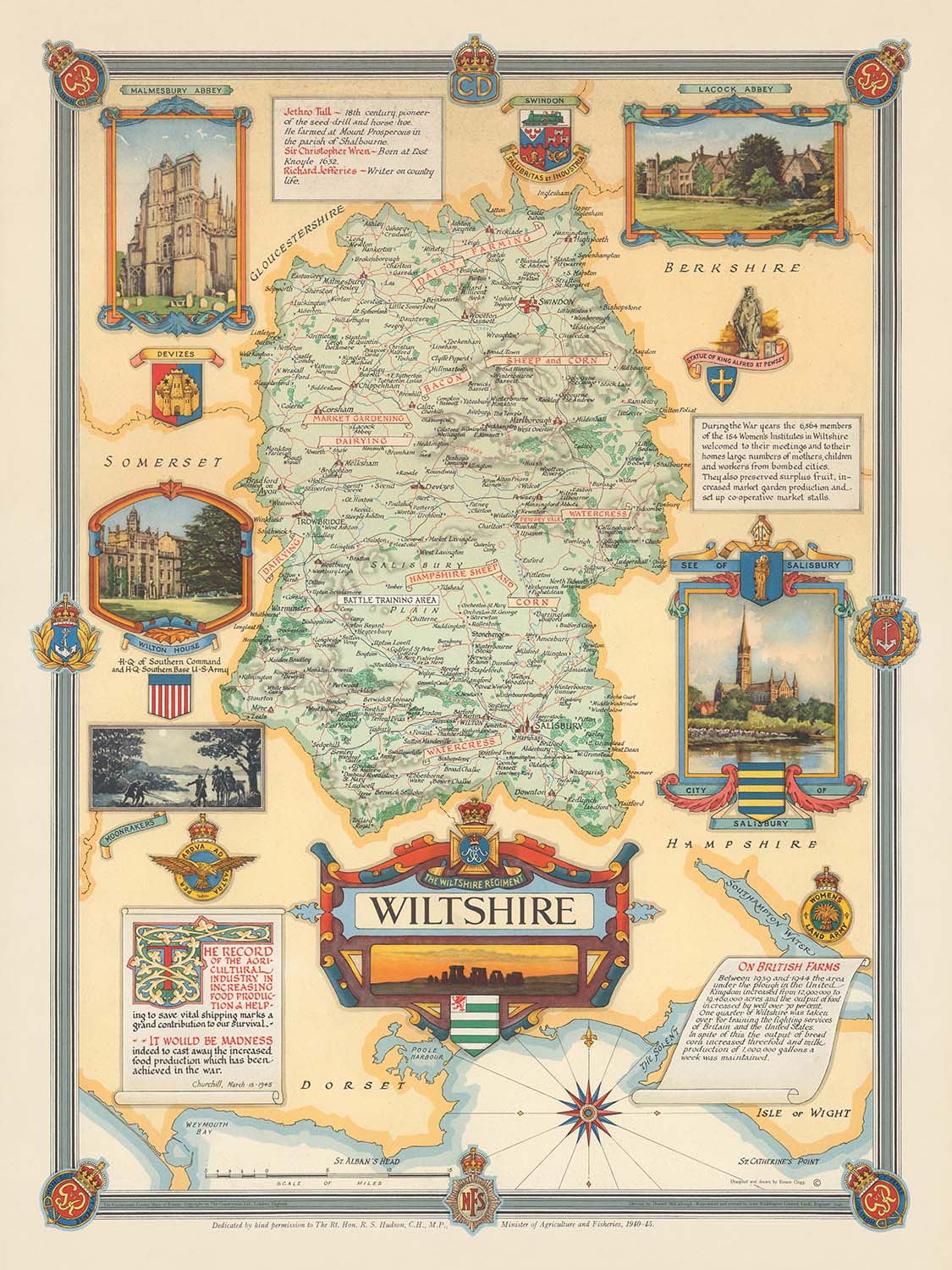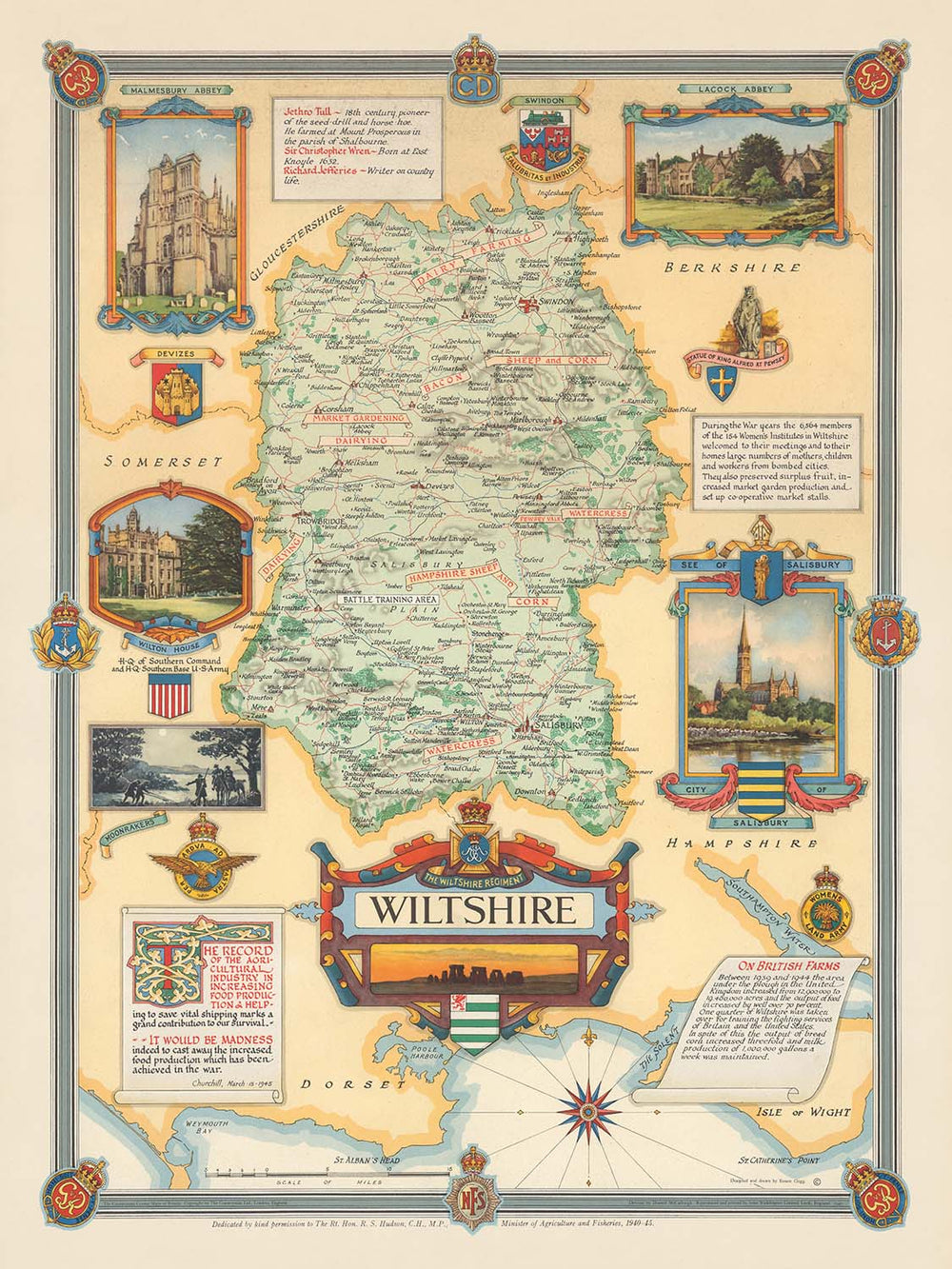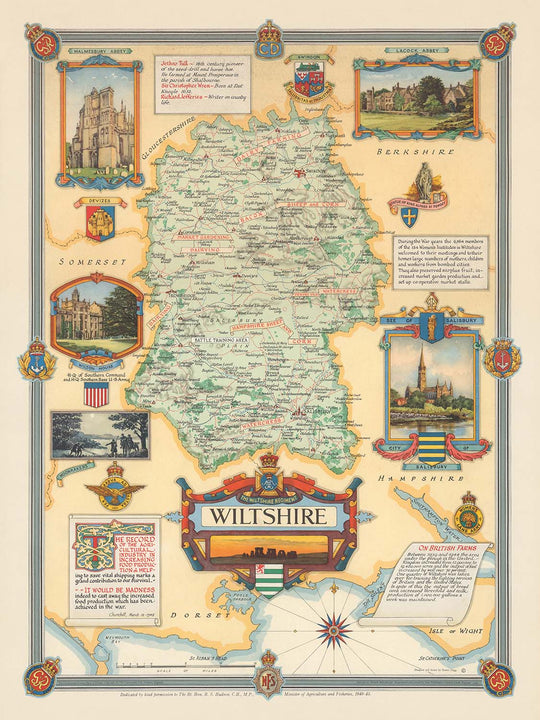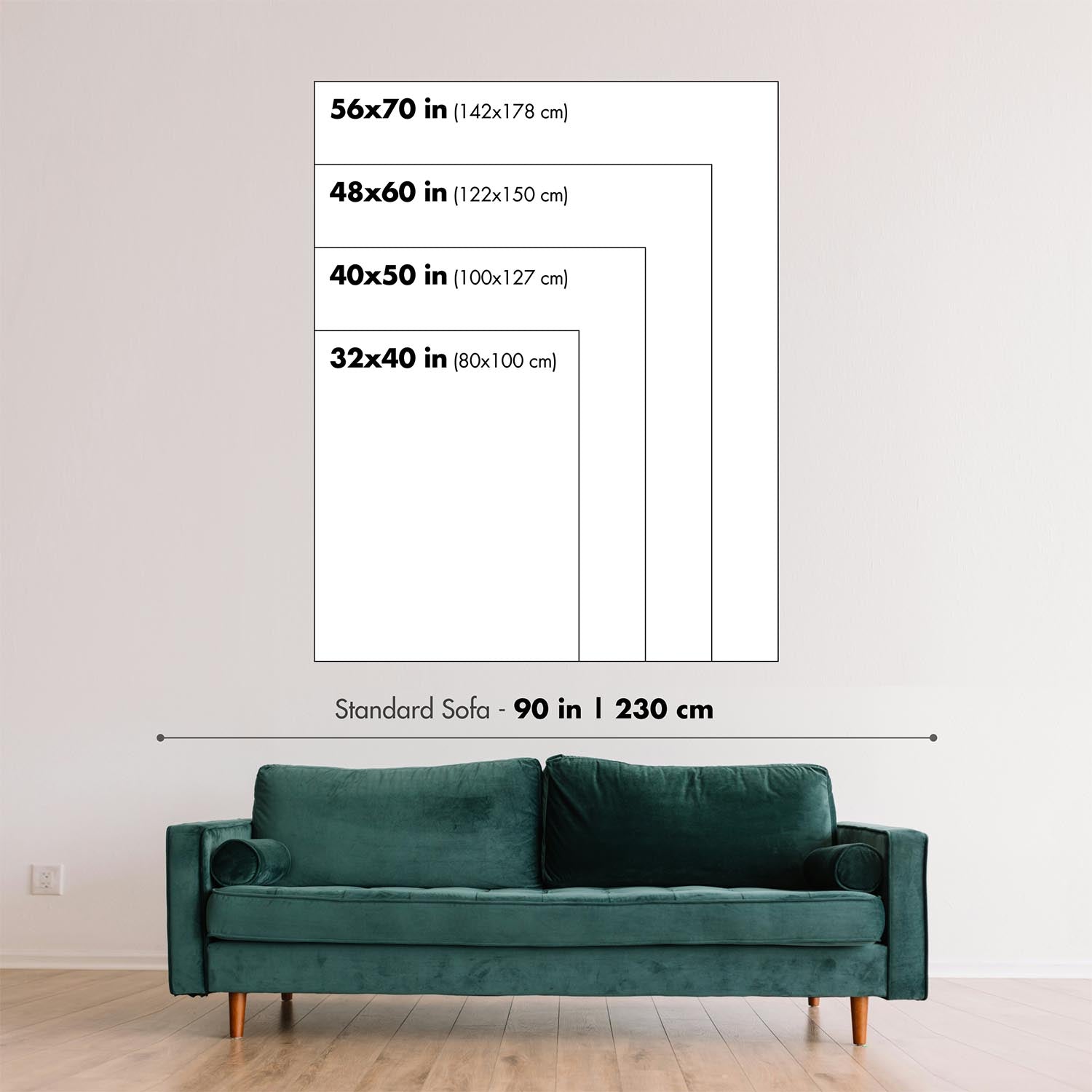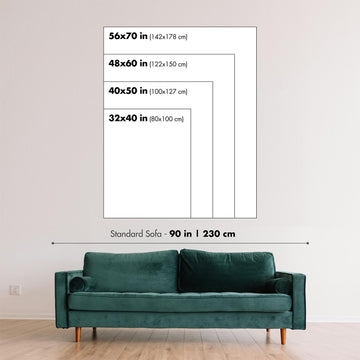- Handmade locally. No import duty or tax
- FREE Delivery by Christmas
- Love it or your money back (90 days)
- Questions? WhatsApp me any time
Own a piece of history
5,000+ 5 star reviews


The 1946 map of Wiltshire, created by the esteemed cartographer Ernest Clegg, is a magnificent example of mid-20th-century pictorial cartography. This map, rich in historical context and artistic detail, offers a vivid representation of Wiltshire, England, during a pivotal period. The map is adorned with intricate illustrations of landmarks such as Malmesbury Abbey, Lacock Abbey, and the iconic Salisbury Cathedral, capturing the essence of Wiltshire's architectural heritage. Clegg's work is not just a geographical tool but a celebration of the region's historical and cultural significance.
Ernest Clegg, known for his detailed and artistic maps, imbued this creation with both aesthetic appeal and informative content. His dedication to accuracy and artistry is evident in the relief shading that highlights the terrain and the meticulously drawn coats of arms that frame the map. Clegg's maps are not merely functional; they are works of art that tell a story, and this map of Wiltshire is no exception. It stands as a testament to his skill and passion for cartography.
The map is particularly notable for its depiction of Wiltshire's agricultural landscape during World War II. A detailed note describes the progress of agriculture and the invaluable contributions of the Land Army between 1939 and 1944. Areas of notable agricultural activity, such as dairying and sheep farming, are marked in red, providing a fascinating insight into the region's wartime economy. This thematic focus not only highlights the region's resilience but also its pivotal role in supporting the war effort.
In addition to its agricultural emphasis, the map features historical notes and scenes that enrich its narrative. The inclusion of figures like Jethro Tull and Richard Jefferies, alongside illustrations of historical events and landmarks, offers a layered understanding of Wiltshire's past. The border of the map is adorned with views of significant landmarks and scenes, creating a visual journey through the county's history and heritage. Each element is carefully chosen to reflect the rich tapestry of Wiltshire's cultural and historical landscape.
Wiltshire's geographical features are meticulously detailed, with major cities and towns such as Swindon, Salisbury, and Trowbridge clearly marked. The map also shows the intricate network of roads and rivers that crisscross the county, providing a comprehensive view of its topography. The inclusion of a compass rose and relief shading adds to the map's navigational utility, while the dedication note in the lower margin underscores its historical significance. This map is not just a representation of Wiltshire; it is a window into its soul, capturing the essence of a region steeped in history and tradition.
Cities and towns on this map
- Swindon
- Salisbury
- Trowbridge
- Chippenham
- Warminster
- Devizes
- Melksham
- Amesbury
- Marlborough
- Westbury
- Calne
- Corsham
- Wootton Bassett
- Malmesbury
- Bradford-on-Avon
- Tidworth
- Ludgershall
- Pewsey
- Cricklade
- Mere
- Wilton
- Highworth
- Downton
Notable Features & Landmarks
- Malmesbury Abbey
- Lacock Abbey
- Salisbury Cathedral
- Stonehenge
- Battle Training Area
- South West Command and R.A.S.C. Southern Command
- Wiltshire Regiment insignia
- Historical note on Jethro Tull
- Historical note on Richard Jefferies
- Note on the Land Army's contributions during World War II
- Depiction of agricultural activities (e.g., dairying, sheep and corn farming)
- Coats of arms of various regions and families
- Historical scenes and illustrations
- Relief shading to indicate terrain
- Compass rose in the lower right corner
- Dedication note in the lower margin
Historical and design context
- Creation date: 1946
- Mapmaker/Publisher: Ernest Clegg
- Themes and topics:
- Agriculture: The map includes a note describing the progress of agriculture and the work of the Land Army in Wiltshire during World War II (1939-1944).
- Historical notes: Blocks of historical notes are included on the map.
- Landmarks and scenes: The border features views of landmarks and scenes.
- Coats of arms: Various coats of arms are depicted around the map.
- Regions shown: Wiltshire, England, with neighboring counties (Berkshire, Hampshire, Dorset, Somerset, and Gloucestershire) partially visible.
- Design and style:
- Pictorial elements: The map is highly decorative with pictorial representations of landmarks and historical scenes.
- Relief: Relief is shown by shadings to indicate the terrain.
- Dedication note: Includes a dedication note in the lower margin.
- Historical significance:
- World War II context: The map highlights the contributions of the Land Army and the agricultural efforts in Wiltshire during World War II.
- Agricultural products: Notable agricultural products and farming areas are marked in red.
- Landmarks and historical context: The map provides historical context through its depiction of landmarks and historical notes.
Please double check the images to make sure that a specific town or place is shown on this map. You can also get in touch and ask us to check the map for you.
This map looks great at every size, but I always recommend going for a larger size if you have space. That way you can easily make out all of the details.
This map looks amazing at sizes all the way up to 90in (230cm). If you are looking for a larger map, please get in touch.
The model in the listing images is holding the 16x20in (40x50cm) version of this map.
The fifth listing image shows an example of my map personalisation service.
If you’re looking for something slightly different, check out my collection of the best old maps to see if something else catches your eye.
Please contact me to check if a certain location, landmark or feature is shown on this map.
This would make a wonderful birthday, Christmas, Father's Day, work leaving, anniversary or housewarming gift for someone from the areas covered by this map.
This map is available as a giclée print on acid free archival matte paper, or you can buy it framed. The frame is a nice, simple black frame that suits most aesthetics. Please get in touch if you'd like a different frame colour or material. My frames are glazed with super-clear museum-grade acrylic (perspex/acrylite), which is significantly less reflective than glass, safer, and will always arrive in perfect condition.
This map is also available as a float framed canvas, sometimes known as a shadow gap framed canvas or canvas floater. The map is printed on artist's cotton canvas and then stretched over a handmade box frame. We then "float" the canvas inside a wooden frame, which is available in a range of colours (black, dark brown, oak, antique gold and white). This is a wonderful way to present a map without glazing in front. See some examples of float framed canvas maps and explore the differences between my different finishes.
For something truly unique, this map is also available in "Unique 3D", our trademarked process that dramatically transforms the map so that it has a wonderful sense of depth. We combine the original map with detailed topography and elevation data, so that mountains and the terrain really "pop". For more info and examples of 3D maps, check my Unique 3D page.
For most orders, delivery time is about 3 working days. Personalised and customised products take longer, as I have to do the personalisation and send it to you for approval, which usually takes 1 or 2 days.
Please note that very large framed orders usually take longer to make and deliver.
If you need your order to arrive by a certain date, please contact me before you order so that we can find the best way of making sure you get your order in time.
I print and frame maps and artwork in 23 countries around the world. This means your order will be made locally, which cuts down on delivery time and ensures that it won't be damaged during delivery. You'll never pay customs or import duty, and we'll put less CO2 into the air.
All of my maps and art prints are well packaged and sent in a rugged tube if unframed, or surrounded by foam if framed.
I try to send out all orders within 1 or 2 days of receiving your order, though some products (like face masks, mugs and tote bags) can take longer to make.
If you select Express Delivery at checkout your order we will prioritise your order and send it out by 1-day courier (Fedex, DHL, UPS, Parcelforce).
Next Day delivery is also available in some countries (US, UK, Singapore, UAE) but please try to order early in the day so that we can get it sent out on time.
My standard frame is a gallery style black ash hardwood frame. It is simple and quite modern looking. My standard frame is around 20mm (0.8in) wide.
I use super-clear acrylic (perspex/acrylite) for the frame glass. It's lighter and safer than glass - and it looks better, as the reflectivity is lower.
Six standard frame colours are available for free (black, dark brown, dark grey, oak, white and antique gold). Custom framing and mounting/matting is available if you're looking for something else.
Most maps, art and illustrations are also available as a framed canvas. We use matte (not shiny) cotton canvas, stretch it over a sustainably sourced box wood frame, and then 'float' the piece within a wood frame. The end result is quite beautiful, and there's no glazing to get in the way.
All frames are provided "ready to hang", with either a string or brackets on the back. Very large frames will have heavy duty hanging plates and/or a mounting baton. If you have any questions, please get in touch.
See some examples of my framed maps and framed canvas maps.
Alternatively, I can also supply old maps and artwork on canvas, foam board, cotton rag and other materials.
If you want to frame your map or artwork yourself, please read my size guide first.
My maps are extremely high quality reproductions of original maps.
I source original, rare maps from libraries, auction houses and private collections around the world, restore them at my London workshop, and then use specialist giclée inks and printers to create beautiful maps that look even better than the original.
My maps are printed on acid-free archival matte (not glossy) paper that feels very high quality and almost like card. In technical terms the paper weight/thickness is 10mil/200gsm. It's perfect for framing.
I print with Epson ultrachrome giclée UV fade resistant pigment inks - some of the best inks you can find.
I can also make maps on canvas, cotton rag and other exotic materials.
Learn more about The Unique Maps Co.
Map personalisation
If you're looking for the perfect anniversary or housewarming gift, I can personalise your map to make it truly unique. For example, I can add a short message, or highlight an important location, or add your family's coat of arms.
The options are almost infinite. Please see my map personalisation page for some wonderful examples of what's possible.
To order a personalised map, select "personalise your map" before adding it to your basket.
Get in touch if you're looking for more complex customisations and personalisations.
Map ageing
I have been asked hundreds of times over the years by customers if they could buy a map that looks even older.
Well, now you can, by selecting Aged before you add a map to your basket.
All the product photos you see on this page show the map in its Original form. This is what the map looks like today.
If you select Aged, I will age your map by hand, using a special and unique process developed through years of studying old maps, talking to researchers to understand the chemistry of aging paper, and of course... lots of practice!
If you're unsure, stick to the Original colour of the map. If you want something a bit darker and older looking, go for Aged.
If you are not happy with your order for any reason, contact me and I'll get it fixed ASAP, free of charge. Please see my returns and refund policy for more information.
I am very confident you will like your restored map or art print. I have been doing this since 1984. I'm a 5-star Etsy seller. I have sold tens of thousands of maps and art prints and have over 5,000 real 5-star reviews. My work has been featured in interior design magazines, on the BBC, and on the walls of dozens of 5-star hotels.
I use a unique process to restore maps and artwork that is massively time consuming and labour intensive. Hunting down the original maps and illustrations can take months. I use state of the art and eye-wateringly expensive technology to scan and restore them. As a result, I guarantee my maps and art prints are a cut above the rest. I stand by my products and will always make sure you're 100% happy with what you receive.
Almost all of my maps and art prints look amazing at large sizes (200cm, 6.5ft+) and I can frame and deliver them to you as well, via special oversized courier. Contact me to discuss your specific needs.
Or try searching for something!







